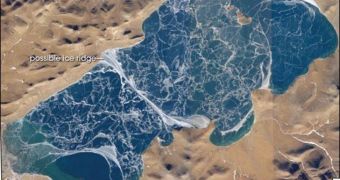Astronauts from the International Space Station (ISS) have recently collected a series of images depicting an alpine lake in Tibet. Upon reviewing the photos, scientists determined that the landscape feature was covered with intricate patterns of ice cracks, which could not be readily explained.
As evidenced in the attached image, the cracks appear to follow a complex, random pattern, which is very rare in nature. Investigators say that Lake Puma Yumco is especially interesting to behold. Winter provides the best conditions for noticing this phenomenon.
Climate scientists say that the surface of the lake gets to look this way because the first ice sheets that form when winter comes have a tendency to fracture, disperse, and then freeze again. The process repeats itself whenever temperature and wind variations are registered around the lakes.
According to measurements conducted by the ISS astronauts, it would appear that Lake Puma Yumco is located at an altitude of about 5,030 meters (16,530 feet) above sea level, a fact that also contributes to promoting the lake's interesting behavior.
An added consequence of this high altitude is the fact that nutrient concentrations within the water column and the lake sediments are very low. This means that they do not influence the way ice forms and breaks up in any discernible manner, Our Amazing Planet reports.
Usually, when lakes freeze over, they tend to develop a thick crust of uniform ice, which only breaks apart when the warmer season comes. But, in order for that to happen, environmental conditions must remain steady for at least a short while, allowing the ice to establish itself.
When this does not happen, only superficial layers of water freeze over, while the others do not. Slight variations in ambient temperatures can then break some of the ice apart, rearranging it into new patterns. When temperatures drop by a few degrees again, the ice solidifies again.
To get a sense of perspective, it's worthy to note here that the lake in this particular image is about 31 by 14 kilometers (19.2 by 8.6 miles). Its blue-green color comes from the fact that it contains very small levels of phytoplankton, microorganisms that carry out photosynthesis at the water surface.
Before the date this image was acquired, temperatures varied between minus 7 and 14 degrees Celsius (19.4 and 57.2 degrees Fahrenheit), according to data collected by a Tibetan weather station in Llasa.

 14 DAY TRIAL //
14 DAY TRIAL //